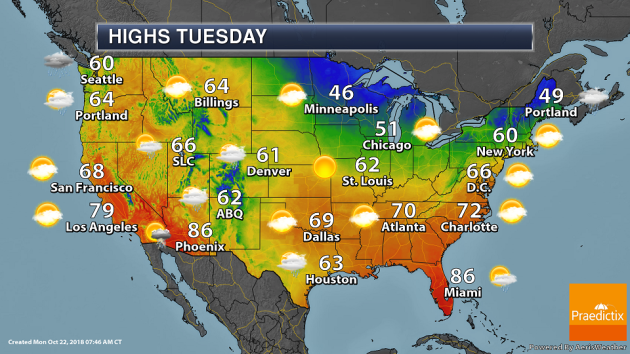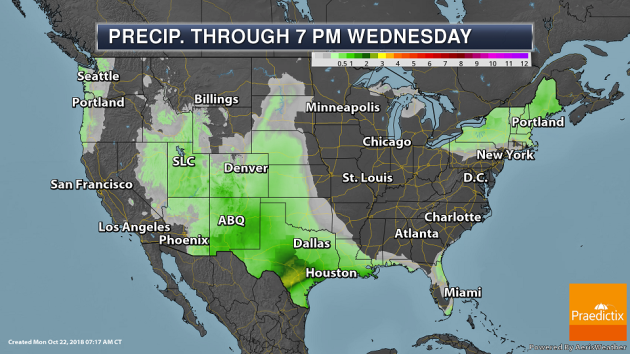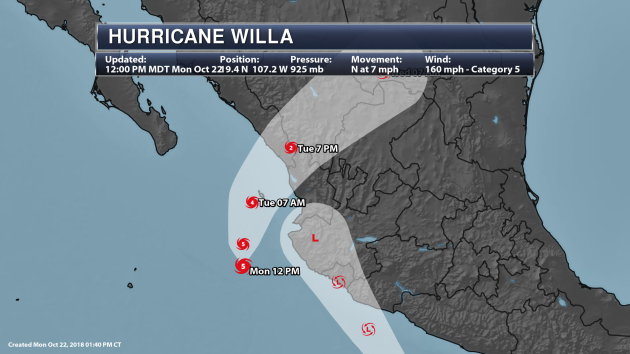National Weather Forecast

On Tuesday a cold front will continue to dive south and east across the country, bringing rain and snow chances across parts of the Northeast. A stationary front near the Gulf Coast will bring rain chances from Texas to the Florida Panhandle. An upper-level trough will bring rain chances (as well as higher elevation snow) to parts of the Four Corners and central/southern Rockies. And to round it all off, showers will be possible in the Pacific Northwest as a cold front moves inland.

The heaviest rain through 7 PM Wednesday is expected across Texas, with 1-3″+ possible. Some of this could be influenced by Willa in the Pacific.

Speaking of Willa, here’s a look at this dangerous hurricane Monday off the Pacific Coast of Mexico. As of Monday morning, the storm had strengthened into a Category 5 hurricane with 160 mph winds.

The system will track right into Mexico on Tuesday as a very strong system, capable of hurricane-force winds, heavy rain, and dangerous storm surge.

Parts of the Rockies and northern Maine could pick up 6″+ of snow through 7 PM Wednesday, with lesser amounts possible in parts up upstate New York and into Wyoming.
Meanwhile, we will be watching the potential of a coastal low forming as we head into the weekend across the East Coast. This system would have the potential to bring heavy rain, snow, gusty winds, and coastal flooding along with it. It is too early for exact details, as this system could swing further inland or further out to sea. It will be a system to keep an eye on over the next several days, however.
_______________________________________________
The most important science policy issue in every state
Popular Science has more: “Wildfires burning around the West. Rising seas lapping at the East. Animal feces, coal ash, and fertilizer fouling waterways from the Carolinas to the Midwest. Bridges, roads, and pipelines crumbling across the country. With the midterm elections less than a month away, communities across the United States face some of the most formidable scientific, environmental, and technological challenges in decades. On November 6, voters from Alaska to Florida will choose not just their next governor, state representative, or member of Congress, but to some degree how we live for decades to come. “This is the most important election of our lifetime,” says Bill Holland, State Policy Director for the League of Conservation Voters. In the 36 gubernatorial and 470 congressional races around the country, some of these challenges, like opioids and fossil fuels, are campaign issues, while others, such as climate change’s role in severe wildfires, don’t appear on any candidates’ platform. But, whether these matters are on their minds, the victors will face them once sworn in. Their decisions will help shape how well storm-ravaged communities adapt, whether the water is safe to drink, how open our internet will be, and more.”
A new wind turbine inspired by a palm tree, big as the Empire State Building
More from Marketplace: “The Energy Information Administration says the United States got about 11 percent of its energy from renewable sources last year. Climate scientists say that’s going to have to go up a lot to ward off the worst effects of climate change. The Department of Energy says the U.S. is one of the fastest-growing markets for wind power in the world. That’s mostly on land. Eric Loth, at the University of Virginia, is an engineer who’s part of a team building the next generation of offshore wind turbines. Those turbines towering over fields or deserts usually produce 5 megawatts of power each. “We want to have turbines as large as 50 megawatts,” Loth said. “And the size of that would be like the Empire State Building, even larger. So you’re talking about being able to power a small city with one of these wind farms. And I think that’s where we’re going. That’s where the future is.””
Environmental Regulation Has Helped Cut Deaths From Air Pollution in Half, Study Finds
More from Earther: “There are plenty of reasons to be worried about air quality these days, from the Environmental Protection Agency killing an expert panel on dangerous particulate matter to the Trump administration’s plan to scrap mercury regulations. But today, we got some good news to remind everyone about the value of environmental regulations that keep pollution in check. Air pollution is killing fewer people than it used to, according to a study published in the Atmospheric Chemistry and Physics Journal Friday. Deaths related particulate matter (nasty stuff that gets lodged in the lungs and can reach the heart) dropped more than 50 percent nationwide between 1990 and 2010—largey thanks to regulations like the Clean Air Act and federal and state rules on vehicle emissions, according to the report’s authors, who include researchers from the EPA and Department of Energy.”
_______________________________________________
Thanks for checking in and have a great Tuesday! Don’t forget to follow me on Twitter (@dkayserwx) and like me on Facebook (Meteorologist D.J. Kayser)!
– D.J. Kayser


